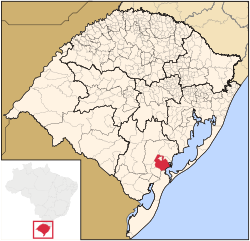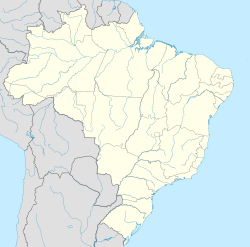Pelotas | |
|---|---|
| Municipality of Pelotas | |
Clockwise from top left: dome of the Metropolitan Cathedral of São Francisco de Paula; partial view of downtown Pelotas; Law Faculty of the Federal University of Pelotas; Anglican Cathedral of the Redeemer; countryside in Quilombo District; and Bank of Brazil | |
| Nickname: Princess of the South | |
 Location in Rio Grande do Sul, Brazil | |
| Coordinates: 31°46′19″S 52°20′33″W / 31.77194°S 52.34250°W | |
| Country | |
| Region | South |
| State | |
| Founded | 1812 |
| Incorporated | 1832 (town) |
| 1835 (city) | |
| Government | |
| • Mayor | Paula Schild Mascarenhas (PSDB) |
| Area | |
| • Total | 1,609 km2 (621 sq mi) |
| Elevation | 7 m (23 ft) |
| Highest elevation | 429 m (1,407 ft) |
| Lowest elevation | 0 m (0 ft) |
| Population (2022 [2]) | |
| • Total | 325,685 |
| • Density | 200/km2 (520/sq mi) |
| Demonym | Pelotense |
| Time zone | UTC−3 (BRT) |
| Website | Prefeitura de Pelotas |
Pelotas (Portuguese pronunciation: [peˈlɔtɐs]) is a Brazilian city and municipality (município), the fourth most populous in the southern state of Rio Grande do Sul, after Porto Alegre, Caxias do Sul and Canoas. It is located 270 km (168 mi) from Porto Alegre, the state's capital city, and 130 km (80.8 mi) from the Uruguayan border. The Lagoa dos Patos lies to the east and the São Gonçalo Channel lies to the south, separating Pelotas from the city of Rio Grande.
In the 19th century, Pelotas was Brazil's leading center for the production of dried meat (charque), a staple food made by slaves and destined to feed the slaves of sugarcane, coffee and cocoa plantations across the country.[3][4][5]
Currently Pelotas hosts two major universities, the Federal University of Pelotas,[6] and the Catholic University of Pelotas.[7] Together, they account for a population of 22 thousand higher education students.
The city has three football clubs: Esporte Clube Pelotas (founded 1908),[8] Grêmio Esportivo Brasil (also known as Brasil de Pelotas; founded 1911)[9] and Grêmio Atlético Farroupilha (founded 1926).[10]
- ^ (in Portuguese) Cidades@, Brazilian Institute of Geography and Statistics, Accessed on 20 March 2007.
- ^ IBGE 2022
- ^ (in Portuguese) "O Ciclo do Charque", Universidade Federal de Pelotas, Accessed on 3 April 2007.
- ^ (in Portuguese) "Charqueadas e Charqueadores" Archived 7 February 2012 at the Wayback Machine, Projeto Pelotas Memória, Accessed on 4 April 2007.
- ^ (in Portuguese) "Escravidão" Archived 10 March 2007 at the Wayback Machine, Xangosol, Accessed on 6 April 2007.
- ^ (in Portuguese) Federal University of Pelotas, Accessed on 2 May 2007.
- ^ (in Portuguese) Catholic University of Pelotas, Accessed on 2 May 2007.
- ^ (in Portuguese) Esporte Clube Pelotas, Accessed on 2 May 2007.
- ^ (in Portuguese) Grêmio Esportivo Brasil Archived 22 April 2007 at the Wayback Machine, Accessed on 2 May 2007.
- ^ (in Portuguese) Grêmio Atlético Farroupilha Archived 23 April 2007 at the Wayback Machine, Accessed on 2 May 2007.








